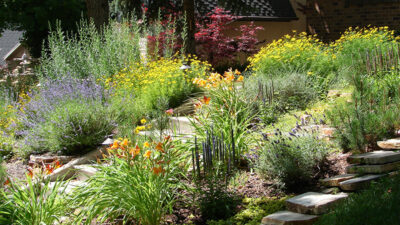Check your answers below to see how much you know about this water-saving climate solution.
1. Landscape irrigation makes up what percentage of urban water use in the West?
c. Nearly 50%
Right now, landscape irrigation makes up nearly half of urban water use in the West, and much of that water is applied to high water use turfgrass. Even though Western states are among the driest in the country, turf areas, including those that don’t serve a function, are still widespread in many communities. That’s why turf replacement can be so impactful in helping states and communities thrive in a future with less water.
Replacing these turf areas, a lot of which serve very little if any function, with drought-tolerant landscaping will help municipalities stretch increasingly limited water supplies over the coming decades. This is especially important because, unlike indoor water use, outdoor water is largely consumptive, meaning it evaporates or is used by the plant and is not returned to the watershed.
Switching to low-water landscaping will increase community resilience to climate change, improve water security and help cities and towns adapt to a present and future with less water. In other words, turning some sprinklers off will help cities keep the taps on.
2. These two states passed legislation to create state-wide programs incentivizing turf replacement during 2022’s legislative sessions.
b. Colorado and Utah
In 2022, WRA helped develop legislation creating the first state-wide turf replacement program in Colorado and advocated for a similar program in Utah. These voluntary programs will ensure every property owner in the state can access financial resources to replace their turf areas with drought-tolerant, sustainable alternatives.
What’s more, states aren’t the only entity offering homeowners incentives to replace their irrigated lawn with drought-efficient plants and grasses. A growing number of Western water providers are creating and advocating for programs that support their customers to swap out underutilized lawn areas for waterwise landscaping. In Colorado, 29 utilities currently provide customers with rebates for replacing water-thirsty plants with low- or no-water alternatives.
In Utah, more than a dozen municipalities participate in the Flip Your Strip program, which encourages residents to remove park-strip grass in their front yard and replace it with waterwise landscaping. The Southern Nevada Water Authority (SNWA), which serves Las Vegas and other areas of the state, has perhaps the most successful turf replacement program in the country. It has saved the state of Nevada nearly 467,000 acre-feet of water – an amount greater than the acre-feet of Colorado River water the state has the right to use each year.
3. Which of the following plants can be used in drought-resistant landscaping?
c. All of the above
Waterwise landscaping will look different across our states and communities. In Arizona, a grassy highway median could be transformed with saguaros and beargrass. In Colorado, a front lawn could be replaced by pops of color with purple gayfeather, yellow rabbitbrush, and blue flax. In New Mexico, orange sunset hyssop and green agave could grow alongside a small, low water buffalo grass lawn in a backyard.

While there is a still a role for functional grass in Western communities — such as playgrounds, parks, sports field, and reasonably-sized backyards — WRA looks forward to a future where more communities feature native plants, reflecting the stunning open spaces that surround them.
Congratulations! You now have the facts about turf replacement!
To support WRA’s work advancing these water-saving solutions, you can make a gift online today.

